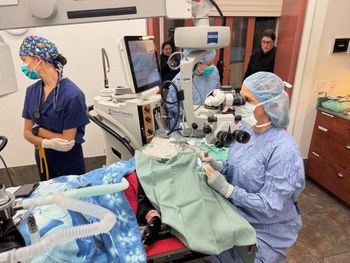
Your treatment options for glaucoma in small animals
Pharmacologic and surgical treatment options provide management of clinical signs, but there is no "cure" for these cases.
This often excruciating ocular disease in pets needs your immediate therapeutic attention, not only to ease the pain but, in the best-case scenario, to retain vision in the affected eye. Early intervention (either medical or surgical) is often a key factor for maintaining normotension and comfort for these patients.
MEDICAL THERAPY
Drug therapy for glaucoma can help on a short- or long-term basis and may delay the onset of glaucoma in the contralateral eye.
Osmotic agents
Osmotic agents are commonly used in the emergency management of glaucoma because of rapid efficacy. They are administered systemically and distributed to extracellular fluids, increasing plasma osmolality. When plasma osmolality exceeds that of the intraocular fluid, water diffuses from the aqueous and vitreous humor down-gradient to plasma, essentially dehydrating the vitreal and aqueous chambers. Common osmotic agents used in veterinary glaucoma patients include mannitol, glycerin and isosorbide.
Mannitol is administered intravenously at dosages ranging from 1 to 2 g/kg over 30 minutes. The reduction in intraocular pressure (IOP) generally begins within 30 minutes to one hour, with effects lasting six to 10 hours. Mannitol is not metabolized but can elevate blood glucose concentrations and should not be administered to diabetic patients. It should be administered through a filter because of its propensity to form crystals.
Glycerin is easy to administer, inexpensive and does not require intravenous access or special storage. It is administered orally at a dosage of 1 to 2 g/kg. A reduction in IOP should be observed within an hour of administration and can last as long as 10 hours. Administration may result in vomiting. Glycerin should not be administered to diabetic patients, as it metabolizes to glucose and will result in hyperglycemia.
Isosorbide can be administered orally like glycerin, but unlike glycerin, it will not result in hyperglycemia. The recommended dosage in dogs is 1 to 1.5 g/kg; efficacy in one report was similar to that of glycerin.1
The use of hyperosmotic agents is contraindicated in uveitic eyes because of the increased permeability of inflamed eyes. They should not be administered with fluids, and water should be withheld for about two hours after administration. Because of the expected increase in intravascular volume associated with these agents, hyperosmotics should not be administered in patients with significant cardiovascular disease.
Carbonic anhydrase inhibitors
Carbonic anhydrase inhibitors (CAIs) inhibit the formation of bicarbonate in the ciliary body that is necessary for aqueous humor production. Commonly used topical agents include dorzolamide and brinzolamide (Azopt-Alcon). Dorzolamide is available as a generic, is fairly cost-effective and is available as a combination drug with timolol, which is now available as a generic. Oral CAIs include methazolamide and acetazolamide.
Topical CAIs can be administered two to three times a day. Maximum efficacy may take four to five days to achieve, but decreased aqueous humor production occurs within 30 minutes to a few hours of dosing. Topical CAIs are effective in both dogs and cats. They can be used in all types of glaucoma, have no effect on pupil size and do not appear to contribute to intraocular inflammation. The efficacy of topical CAIs has been shown to be of equal efficacy to that of systemic CAIs.2
Methazolamide is dosed at 2 to 5 mg/kg orally twice a day. The recommended dosage for acetazolamide is 4 to 8 mg/kg orally two to three times a day, although this medication is rarely used currently because of the potential side effects. Commonly reported side effects of systemic CAIs include polyuria/polydipsia, gastrointestinal upset and panting (to compensate for metabolic acidosis). Systemic CAIs should not be used in patients with respiratory compromise. Cats appear to be more susceptible to metabolic acidosis, so systemic CAIs should be used with extreme caution in this species.
Beta-blockers
Beta-blockers are very effective for the reduction of IOP in people and are the most commonly prescribed class of drugs for the treatment of glaucoma in people. Timolol is the most widely used of these medications in both human and veterinary medicine, but other topical beta-blockers are available, including levobunolol, betaxolol, metipranolol and carteolol.
Beta-blockers reduce IOP by decreasing aqueous humor production, but the exact mechanism of this effect is not completely understood. In dogs and cats, their efficacy is considered relatively poor, and bradycardia and mild (bilateral) miosis associated with their use has been documented.3 Their use in equine glaucoma appears more promising. In veterinary medicine, timolol 0.5% is administered topically twice daily. Use with caution in patients with cardiovascular disease.
Prostaglandin analogues
The prostaglandin analogues appear to be the most effective drugs in the treatment of canine glaucoma. These drugs increase aqueous outflow. The mechanism of action is mediated through binding to prostanoid FP receptors. In dogs and people, activation of the prostanoid FP receptor results in increased uveoscleral outflow (i.e. unconventional outflow) through remodeling of the ciliary body musculature. Increased conventional outflow also occurs through morphological changes in the trabecular meshwork.
The most commonly prescribed prostaglandin analogue in veterinary medicine is latanoprost, which is now available as a generic. Other available prostaglandin analogues include bimatoprost and travoprost. In cats, latanoprost and other prostaglandin analogues are considered less effective because activation of prostanoid EP receptors is required for similar effects in this species. The prostaglandin analogues are generally administered topically twice a day in dogs. In dogs, prostaglandin analogues result in marked miosis. Because they work through activation of inflammatory mediators, they should be used with caution in cases of secondary glaucoma caused by anterior lens luxation or uveitis.
Other drug classes
Other, less commonly used anti-glaucoma drug classes include the cholinergic agonists (pilocarpine, carbachol, demecarium bromide, echothiophate iodide), adrenergic agonists (dipivefrin) and alpha2-adrenergic agonists (apraclonidine, brimonidine). Because of associated local side effects, lack of availability and systemic side effects, they are seldom used.
SURGICAL TREATMENT OPTIONS
If your patient is receiving anti-glaucoma drugs but the IOP is still > 25 mm Hg, it's time to discuss to a surgical option. Recommended surgical options often depend on whether vision is considered salvageable. Surgical options for the visual eye include laser ciliary body cyclophotocoagulation and gonioimplants. Eyes that have lost vision are most commonly treated with enucleation, cyclocryotherapy, chemical ciliary body ablation or intrascleral prosthesis surgery to improve the quality of life by controlling pain related to elevated IOP. Consultation with a veterinary ophthalmologist is often helpful when determining which surgery is right for your patient.
Endolaser cyclophotocoagulation (ECP)
Endolaser cyclophotocoagulation (ECP) is a relatively new surgical option. A diode laser is used to target the pigmented tissue of the ciliary body, thereby photocoagulating nonpigmented epithelium. The advantage of this procedure is that the laser is built into an endoscopic probe, allowing for localization and direct treatment of the ciliary processes with little damage to surrounding tissue. Because the laser energy is likely to induce cataract development, the process is often combined with phacoemulsification. No studies evaluating the long-term efficacy of this surgery have been published, but preliminary results are promising.
Transscleral cyclophotocoagulation (TSCPC)
Transscleral cyclophotocoagulation (TSCPC) involves laser ablation of the ciliary body, similar to ECP. Both Nd:YAG and diode lasers have been used. The main difference between TSCPC and ECP is that TSCPC does not involve direct visualization of the ciliary body. Rather, external landmarks are used to position the laser probe over the external surface of the eye, and the laser energy is directed through the sclera.
Possible postoperative complications include excessive intraocular inflammation (with the potential to induce retinal detachment), cataract development, hyphema, and, as with any glaucoma surgery short of enucleation or evisceration, uncontrolled IOP. Immediate postoperative spikes in IOP are common and can result in postoperative vision loss.
Gonioimplants and valves
Gonioimplants facilitate drainage of aqueous humor through a tubing system implanted directly into the anterior chamber. Both valved and nonvalved implants exist. Valved systems allow for egress of aqueous humor at IOPs > 12 mm Hg, while nonvalved systems are limited only by resistance of the tubing itself. Although these shunt systems are generally efficacious in the short term, postoperative uveitis with fibrin development and valve occlusion, requiring intracameral tissue plasminogen activator administration, is relatively common.
The long-term efficacy of shunts is limited by avascular bleb development, in which an avascular fibrotic capsule develops around the base of the device. This fibrosis is observed so commonly that gonioimplant failure is generally considered inevitable, and implant placement is often combined with a cyclodestructive procedure to provide more long-term control of IOP.
Enucleation
Enucleation is probably the most commonly performed surgery of comfort for glaucoma. Possible postoperative complications include hemorrhage, postoperative fistulas or mucocele development caused by incomplete removal of conjunctival, caruncular or third eyelid glandular tissue and, rarely, orbital emphysema. In cats, the optic nerve is relatively short, and excessive traction on the enucleated globe must be avoided during surgery to prevent damage to the optic chiasm and contralateral blindness.
Cyclocryotherapy
Cyclocryotherapy allows for reduction in IOP without loss of the globe. This procedure is generally reserved for dogs. Nitrous oxide gas can be used. The cryotherapy probe is applied by using external landmarks to estimate the site of probe placement. The cryodose applied depends on the preoperative IOP. The biggest advantage is that the surgery is noninvasive; postoperative therapy generally involves anti-inflammatories (often continued for life). Disadvantages include the potential for persistently elevated IOP, cataract development, hyphema, retinal detachment and globe phthisis.
Chemical ciliary body ablation
Pharmacologic ablation of the ciliary body can be performed with gentamicin or, as more recently described, cidofovir.4 Gentamicin is cytotoxic to both the ciliary body and retina, so it should never be used in a visual eye. Even in blind eyes, however, this procedure should be used with caution since retrospective pathologic studies have reported an increased incidence of intraocular tumor development postoperatively.5,6
The outcome of this procedure is also the least predictable of the cyclodestructive procedures, with published reports citing a success rate of around 65%.7 Other possible postoperative complications include cataract development, retinal detachment, hyphema, chronic uveitis and phthisis. Intravitreal gentamicin should not be administered to patients with renal compromise, as the drug is detectable in plasma postoperatively.8
Evisceration and intrascleral prosthesis
Intrascleral prosthesis surgery involves creating a 180-degree limbal incision at the corneoscleral junction, removing all intraocular contents and replacing these contents with a silicone intraocular prosthetic. The advantages of intrascleral prosthesis include complete resolution of glaucoma and maintenance of a cosmetic globe. Disadvantages include the potential for recurrent corneal ulcerations due to decreased corneal sensitivity (caused both by historical glaucoma and transection of corneal nerves intraoperatively) and the potential for keratoconjunctivitis sicca. Intrascleral prostheses should generally be avoided in eyes with underlying intraocular neoplasia, preoperative keratitis or keratoconjunctivitis sicca.9
PROGNOSIS
Unfortunately, glaucoma remains a disease with no effective “cure,” and although primary glaucoma often presents initially as a unilateral process, most at-risk dogs will develop glaucoma in the contralateral eye within one year of diagnosis. Initiating prophylactic anti-glaucoma and anti-inflammatory treatment in the normotensive eye has been shown to delay the onset of glaucoma in a dog at risk by a median of 324 days.10 Client education and early intervention can delay vision loss and improve the quality of life for your patients.
References
1. Wasserman NT, Kennard G, Cochrane ZN, et al. Effects of oral isosorbide and glycerol on intraocular pressure, serum osmolality, and blood glucose in normal dogs. Vet Ophthalmol 2013;16(1):20-24.
2. Gelatt KN, MacKay EO. Changes in intraocular pressure associated with topical dorzolamide and oral methazolamide in glaucomatous dogs. Vet Ophthalmol 2001;4(1):61-67.
3. Smith LN, Miller PE, Felchle LM. Effects of topical administration of latanoprost, timolol, or a combination of latanoprost and timolol on intraocular pressure, pupil size, and heart rate in clinically normal dogs. Am J Vet Res 2010;71(9):1055-1061.
4. Low MC, Landis ML, Peiffer RL. Intravitreal cidofovir injection for the management of chronic glaucoma in dogs. Vet Ophthalmol 2014;17(3):201-206.
5. Duke FD, Strong TD, Bentley E, et al. Canine ocular tumors following ciliary body ablation with intravitreal gentamicin. Vet Ophthalmol 2013;16(2):159-162.
6. Duke FD, Strong TD, Bentley E, et al. Feline ocular tumors following ciliary body ablation with intravitreal gentamicin. Vet Ophthalmol 2013;16(suppl1):188-190.
7. Gelatt KN. Veterinary ophthalmology. 4th ed. Hoboken, New Jersey: Wiley-Blackwell, 2007.
8. Rankin AJ, Lanuza R, KuKanich B, et al. Measurement of plasma gentamicin concentrations postchemical ciliary body ablation in dogs with chronic glaucoma. Vet Ophthalmol 2015. Epub ahead of print.
9. Blocker T, Hoffman A, Schaeffer DJ, et al. Corneal sensitivity and aqueous tear production in dogs undergoing evisceration with intraocular prosthesis placement. Vet Ophthalmol 2007;10(3):147-154.
10. Dees DD, Fritz KJ, Maclaren NE, et al. Efficacy of prophylactic antiglaucoma and anti-inflammatory medications in canine primary angle-closure glaucoma: a multicenter retrospective study (2004-2012). Vet Ophthalmol 2014;17(3):195-200.
Suggested reading
Plummer CE, Regnier A, Gelatt KN. The canine glaucomas. In: Gelatt, KN, ed. Veterinary ophthalmology. 5th ed., vol.2. Ames, Iowa: Wiley-Blackwell, 2013;1050-1145.
Dr. Micki Armour is a veterinary ophthalmologist with Eye Care for Animals in Leesburg, Virginia, and Frederick, Maryland.
Newsletter
From exam room tips to practice management insights, get trusted veterinary news delivered straight to your inbox—subscribe to dvm360.






